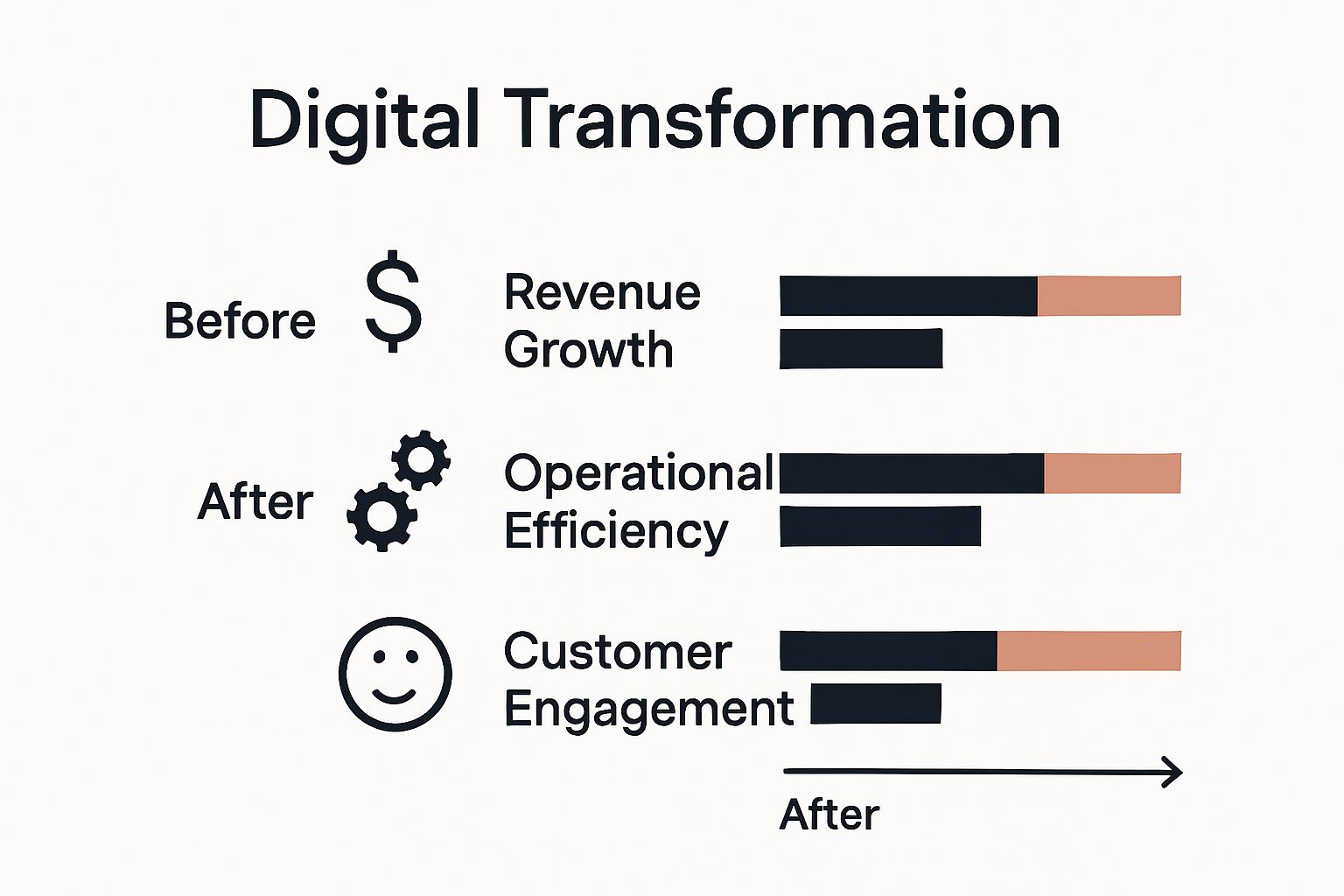Digital transformation sounds like tech jargon that only massive corporations care about. Not exactly. Companies that truly embrace it are 3.5 times more likely to see major revenue growth compared to their slower-moving competitors. Most people picture fancy gadgets and huge budgets, but the biggest shifts are happening behind the scenes—quietly turning old workflows on their heads and giving businesses a real shot at leading the pack.
Table of Contents
- What Is Digital Transformation And Its Benefits?
- The Importance Of Digital Transformation In Modern Business
- How Digital Transformation Enhances Workflow Efficiency
- Key Technologies Driving Digital Transformation Benefits
- Real-World Examples Of Digital Transformation Success
Quick Summary
| Takeaway | Explanation |
|---|---|
| Digital transformation integrates technology and strategy | It’s not just about new tools; it’s about aligning technology with business goals for overall improvement. |
| Organizations gain a competitive edge through agility | Companies that adapt digitally are proven to outperform their rivals in revenue and responsiveness. |
| Automation enhances operational efficiency significantly | Implementing intelligent automation can cut processing times by up to 50%, improving overall accuracy and efficiency. |
| Real-time data analytics drives informed decisions | Leveraging advanced data analytics allows organizations to make better strategic decisions based on current data trends. |
| Holistic approach redefines business models | Successful digital transformation requires rethinking business processes and value delivery, not just technological upgrades. |
What is Digital Transformation and Its Benefits?
Digital transformation represents a fundamental reimagining of how organizations leverage technology to fundamentally change business performance, operational processes, and customer experiences. Understanding digital document transformation for businesses begins with recognizing that this is not merely about implementing new technologies, but strategically integrating digital solutions to drive significant organizational change.
Core Definition and Strategic Approach
At its essence, digital transformation is a comprehensive process where businesses integrate advanced digital technologies across all operational domains. This holistic approach goes beyond simple technological upgrades and involves reimagining business models, enhancing customer interactions, and creating more agile and responsive organizational structures.
Key characteristics of successful digital transformation include:
- Comprehensive technological integration across business functions
- Cultural shifts that embrace continuous innovation and learning
- Strategic alignment between technology investments and business objectives
Technology and Business Performance
According to McKinsey Global Institute, organizations that successfully implement digital transformation strategies can experience significant performance improvements. These improvements often manifest through enhanced operational efficiency, more personalized customer experiences, and the ability to rapidly adapt to market changes.
Businesses pursuing digital transformation typically focus on several critical areas:
- Streamlining internal workflows through automation
- Leveraging data analytics for strategic decision making
- Creating more responsive and interconnected digital ecosystems
The ultimate goal of digital transformation is not just technological adoption but creating a more intelligent, responsive, and competitive business environment that can quickly evolve with changing market demands.
The Importance of Digital Transformation in Modern Business
Digital transformation has become a critical strategic imperative for businesses seeking sustainable competitive advantage in an increasingly technology-driven marketplace. Understanding digital transformation in business reveals how organizations can leverage technological innovations to fundamentally reshape their operational and strategic capabilities.
Competitive Survival and Market Relevance
In today’s rapidly evolving business landscape, organizations that fail to adapt risk becoming obsolete. According to Gartner Research, companies that successfully implement digital transformation strategies are 3.5 times more likely to report significant revenue growth compared to their less adaptive competitors.
Key competitive advantages of digital transformation include:

- Enhanced agility and responsiveness to market changes
- Improved operational efficiency and cost management
- More personalized and engaging customer experiences
Strategic Business Value Creation
Digital transformation transcends mere technological implementation. It represents a holistic approach to reimagining business models, processes, and value delivery mechanisms. Successful digital transformation enables organizations to:
- Generate new revenue streams through innovative digital products
- Optimize internal processes through intelligent automation
- Create data-driven decision-making frameworks
Businesses that embrace digital transformation do not simply adopt new technologies they fundamentally reimagine their approach to value creation, customer engagement, and organizational design. This strategic approach allows them to remain resilient, innovative, and competitive in an increasingly complex global marketplace.
How Digital Transformation Enhances Workflow Efficiency
Digital transformation fundamentally reshapes organizational workflows by leveraging advanced technologies to eliminate inefficiencies and create more streamlined operational processes. Automating business processes with Adobe PDF solutions demonstrates how targeted technological interventions can dramatically improve organizational productivity.
Automation and Process Optimization
Workflow efficiency emerges from systematic elimination of manual, repetitive tasks through intelligent automation technologies. According to Deloitte Global Automation Research, organizations implementing comprehensive digital transformation strategies can reduce operational processing time by up to 50% while simultaneously improving accuracy and reducing human error.
Key workflow efficiency improvements include:
-
Reduction of manual data entry and document processing
-
Enhanced real-time collaboration across distributed teams
-
Seamless integration of cross-functional business systems
Technology-Driven Performance Acceleration
Digital transformation enables businesses to create intelligent workflows that adapt and respond dynamically to changing operational requirements. Advanced technologies like artificial intelligence and machine learning allow organizations to:
- Predict potential workflow bottlenecks before they occur
- Automatically route tasks and documents to appropriate team members
- Generate actionable insights from complex operational data
By systematically reimagining workflow structures through technological innovation, businesses can achieve unprecedented levels of operational efficiency, responsiveness, and strategic agility.

Key Technologies Driving Digital Transformation Benefits
Digital transformation is powered by an interconnected ecosystem of advanced technologies that collectively enable businesses to reimagine their operational capabilities. Digital project management strategies for enterprise environments highlight how strategic technology integration can revolutionize organizational performance.
Foundational Technological Infrastructures
The core technologies driving digital transformation create a robust framework for business innovation and strategic adaptation. According to Gartner Digital Transformation Research, organizations are increasingly leveraging sophisticated technological platforms that enable unprecedented levels of operational intelligence and adaptability.
Critical technological foundations include:
- Cloud computing infrastructure
- Advanced data analytics platforms
- Artificial intelligence and machine learning systems
Emerging Technology Convergence
Modern digital transformation is characterized by the convergence of multiple technological domains, creating synergistic capabilities that transcend traditional operational boundaries. Businesses are now implementing integrated technological ecosystems that enable:
- Seamless cross-platform data integration
- Real-time predictive analytics
- Intelligent automation across complex business processes
By strategically combining these advanced technologies, organizations can create dynamic, responsive digital environments that continuously evolve to meet changing business requirements and market demands.
Here is a table summarizing the foundational and emerging technologies that drive digital transformation, along with the primary benefits they offer businesses.
| Technology Category | Example Technologies | Primary Benefits |
|---|---|---|
| Foundational Infrastructures | Cloud computing, data analytics platforms | Scalable operations, real-time insights |
| Artificial Intelligence & Machine Learning | AI-driven analytics, automation tools | Predictive insights, intelligent automation |
| Real-time Data Integration | Cross-platform integration tools | Unified workflows, seamless collaboration |
| Predictive Analytics | Advanced analytics platforms | Anticipates trends, proactive business decisions |
| Intelligent Automation | Automated routing systems, document management | Streamlined processes, enhanced efficiency |
Real-World Examples of Digital Transformation Success
Digital transformation transcends theoretical concepts, delivering tangible business outcomes across diverse industries through strategic technological implementation. Understanding digital document transformation for businesses reveals how organizations convert technological potential into practical, measurable success.
Healthcare Industry Transformation
Healthcare organizations have dramatically reimagined patient care and operational efficiency through digital transformation technologies. According to Harvard Business Review Digital Transformation Research, hospitals implementing comprehensive digital strategies have achieved significant improvements in patient outcomes and operational performance.
Key digital transformation achievements in healthcare include:
- Telemedicine platform development
- Electronic health record integration
- Advanced diagnostic predictive analytics
Financial Services Digital Evolution
Financial institutions have leveraged digital transformation to revolutionize customer experiences and internal processes. Banks and financial service providers are now implementing advanced technologies that fundamentally restructure traditional banking models, enabling:
- Mobile banking application development
- AI-powered fraud detection systems
- Personalized financial recommendation platforms
By embracing technological innovation, organizations across multiple sectors demonstrate that digital transformation is not just a technological upgrade but a comprehensive strategic approach to reimagining business capabilities and delivering exceptional value to customers.
The following table highlights how digital transformation delivers measurable business value in the healthcare and financial services industries, focusing on key areas of practical impact.
| Industry | Digital Transformation Initiatives | Key Benefits Achieved |
|---|---|---|
| Healthcare | Telemedicine, EHR integration, predictive analytics | Improved patient outcomes, operational efficiency |
| Financial Services | Mobile banking, AI-powered fraud detection, personalized platforms | Enhanced customer experience, streamlined operations |
Turn Digital Transformation Insights Into Measurable Results With Mapsoft
Are your teams facing roadblocks with manual workflows or struggling to keep up with growing document demands? If your organization is seeking the real benefits of digital transformation—faster processes, greater accuracy, and more secure digital assets—Mapsoft can help you move from theory to action. Explore the possibilities of advanced digital preservation so your documents stay accessible and protected for years to come.

Now is the time to optimize your digital document processes. With Mapsoft’s expertise in Adobe technology, you can automate PDF management, streamline project workflows, and strengthen your digital infrastructure. Visit Mapsoft.com to discover powerful plugins, workflow solutions, and tailored consulting services that will help your business thrive in the digital age. Start your journey to enhanced productivity and long-term digital security today.
Frequently Asked Questions
What is digital transformation?
Digital transformation is a holistic process where organizations integrate advanced digital technologies across all operational domains to fundamentally change business performance, operational processes, and customer experiences.
What are the main benefits of digital transformation for businesses?
The main benefits include enhanced operational efficiency, improved customer experiences, increased agility to respond to market changes, and the creation of new revenue streams through innovative digital products.
How does digital transformation improve workflow efficiency?
Digital transformation improves workflow efficiency by leveraging automation technologies to eliminate manual tasks, enhance real-time collaboration, and integrate cross-functional business systems, which streamlines operational processes.
What technologies are driving digital transformation?
Key technologies driving digital transformation include cloud computing, advanced data analytics platforms, artificial intelligence, and machine learning systems, which together create a robust framework for business innovation.



